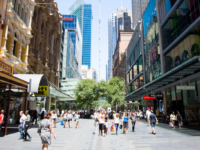Black Friday sales pushed Australian retail sales up by 2.2 per cent to $36.51 billion in November last year, Australian Bureau of Statistics (ABS) data showed.
The cafes, restaurants, and takeaway category climbed 4.3 per cent to $5.41 billion while the food category increased 2.8 per cent to $14.26 billion, which Australian Retailers Association (ARA) CEO Paul Zahra said reflects how consumers prioritise essentials amid a cost-of-living crisis.
“Shoppers are increasingly feeling the crunch of cost-of-living pressures and interest rate increases, making it a challenging time to be a discretionary retailer,” Zahra said.
November is traditionally the strongest month for retail, but the Melbourne Cup Day interest-rate rise “stopped spending in its tracks,” National Retail Association (NRA) director Rob Godwin said.
Department stores inched 3.3 per cent higher to $2 billion and household goods rose 0.5 per cent to $6.25 billion. Clothing, footwear, and accessories, however, fell 0.1 per cent to $3.08 billion.
“Black Friday sales were again a big hit this year, with retailers starting promotional periods earlier and running them for longer, compared to previous years,” ABS head of business statistics Robert Ewing said. “The strong rise suggests that consumers held back on discretionary spending in October to take advantage of discounts in November. Shoppers may have also brought forward some Christmas spending that would usually happen in December.”
All states showed retail sales growth during the month, with the ACT leading at 5.2 per cent as sales value hit $689 million. SA ranked second at 4.5 per cent and a sales value of $2.37 billion.
“While spending expectations heading into the broader pre-Christmas spending period were subdued, the growing popularity of Black Friday gave retailers some much-needed reprieve with shoppers seeking out bargains amid intense financial pressure,” Zahra said. “This certainly contributed to November’s overall spending growth, especially considering the Reserve Bank of Australia’s decision to raise the cash rate on Melbourne Cup Day.”
Godwin, meanwhile, urged the RBA to cut interest rates as the latest figures reflect how consumers had to wait for the pre-Christmas sales event to purchase household essentials.
“The Reserve Bank said they wanted to squeeze spending. Well, spending has been well and truly squeezed,” he said. “We predict the first quarter of 2024 is going to be the most challenging quarter for businesses in many years.”
This story first appeared on our sister publication Inside Retail














